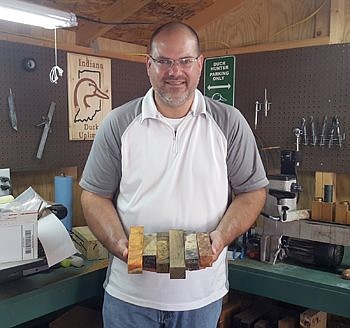Cesco Makes His Mark With Duck, Goose Calls
June 10, 2017 at 4:38 a.m.

Cesco Makes His Mark With Duck, Goose Calls
By Mark [email protected]
The precursor to making calls was, of course, hunting. Cesco grew up on the north side of Tippecanoe Lake and said that, relatively speaking, he got a later in life start in hunting, but with men close to him.
“I got started hunting 30-some odd years ago with my dad and my Wawasee football coach, Myron Dickerson,” Cesco said. “When you hunt, you have to learn to call.
“From there, I started making my own calls about 10 years ago.”
The calls are different from the mass-produced items found at an outdoors store or gun shop. Cesco said his calls are made either from acrylic or a variety of woods. The most exotic (and therefore costly) the wood, the more expensive the custom call. The types of wood range from maple to African black wood or cocoboca.
Burls, or small knotholes, make the call more attractive. Other things that affect the quality and cost of a call are inlays, stippling (the creation of a pattern simulating varying degrees of solidity or shading by using small dots) and the tone board.
Cesco sells his calls primarily from his website www.coldfrontcalls.com. The name comes from birds using a cold front to fly long distances with less effort. He’s shipped calls from coast-to-coast, including Alaska, and has a customer in Japan.
Each call takes about 3-1/2 hours to make, and Cesco said he’s about six months behind on his orders.
The best callers compete on local and world stages. Cesco hosted the Northern Indiana Calling Competition June 3 at the Center Lake Pavillion. He explained that in competition, the caller is trying to lure in ducks or geese by using certain signals, not unlike a language the birds understand.
“You’re painting a picture in the judge’s mind on the call and the sequence you’re doing. Each call has a different meaning to the ducks,” Cesco said. “So you’re painting a picture; if the ducks are real far away, you get their attention, you’re bringing them toward you, they’re starting to come down, then they’re starting to flare off and you have to get their attention to come back.
“You’re judged on getting the birds to finish again, on finishing calls or sounds. You’re painting a picture of an actual hunting situation by using different sounds from the duck call.”
While 20 callers came to Warsaw from Minnesota, Wisconsin, western Illinois, Kentucky, Tennessee and Michigan, only those from Indiana were eligible for the contest. Rob Miles of LaGrange won and qualified for the World Championship Duck Calling Contest in Stuttgart, Ark. on Nov. 25.
“Indiana is not known for its competition callers. We’re just not a hotbed for duck hunting,” Cesco said. “If you were living in Arkansas, Missouri, Iowa or Minnesota, you’d know about it.”
For more information about calls or future competitions, visit www.coldfrontcalls.com or Cesco’s Facebook page.
The precursor to making calls was, of course, hunting. Cesco grew up on the north side of Tippecanoe Lake and said that, relatively speaking, he got a later in life start in hunting, but with men close to him.
“I got started hunting 30-some odd years ago with my dad and my Wawasee football coach, Myron Dickerson,” Cesco said. “When you hunt, you have to learn to call.
“From there, I started making my own calls about 10 years ago.”
The calls are different from the mass-produced items found at an outdoors store or gun shop. Cesco said his calls are made either from acrylic or a variety of woods. The most exotic (and therefore costly) the wood, the more expensive the custom call. The types of wood range from maple to African black wood or cocoboca.
Burls, or small knotholes, make the call more attractive. Other things that affect the quality and cost of a call are inlays, stippling (the creation of a pattern simulating varying degrees of solidity or shading by using small dots) and the tone board.
Cesco sells his calls primarily from his website www.coldfrontcalls.com. The name comes from birds using a cold front to fly long distances with less effort. He’s shipped calls from coast-to-coast, including Alaska, and has a customer in Japan.
Each call takes about 3-1/2 hours to make, and Cesco said he’s about six months behind on his orders.
The best callers compete on local and world stages. Cesco hosted the Northern Indiana Calling Competition June 3 at the Center Lake Pavillion. He explained that in competition, the caller is trying to lure in ducks or geese by using certain signals, not unlike a language the birds understand.
“You’re painting a picture in the judge’s mind on the call and the sequence you’re doing. Each call has a different meaning to the ducks,” Cesco said. “So you’re painting a picture; if the ducks are real far away, you get their attention, you’re bringing them toward you, they’re starting to come down, then they’re starting to flare off and you have to get their attention to come back.
“You’re judged on getting the birds to finish again, on finishing calls or sounds. You’re painting a picture of an actual hunting situation by using different sounds from the duck call.”
While 20 callers came to Warsaw from Minnesota, Wisconsin, western Illinois, Kentucky, Tennessee and Michigan, only those from Indiana were eligible for the contest. Rob Miles of LaGrange won and qualified for the World Championship Duck Calling Contest in Stuttgart, Ark. on Nov. 25.
“Indiana is not known for its competition callers. We’re just not a hotbed for duck hunting,” Cesco said. “If you were living in Arkansas, Missouri, Iowa or Minnesota, you’d know about it.”
For more information about calls or future competitions, visit www.coldfrontcalls.com or Cesco’s Facebook page.
Have a news tip? Email [email protected] or Call/Text 360-922-3092

